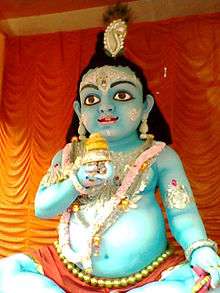Gopal (Krishna)

Gopal (Sanskrit: गोपाल Gopāla, literally "cow protector") is the infant/child form of Lord Krishna, the Cowherd Boy who enchanted the Cowherd Maidens (Gopinis) with the divine sound of his flute, attracting even Kāmadeva (the Hindu god of love and passion). Historically one of the earliest forms of worship in Krishnaism or Vaishnava dharma, it is believed to be a key element of the early history of the worship of Krishna. This tradition is considered separately to other traditions that led to amalgamation at a later stage of historical development. Other traditions are Bhagavatism and the Cult of Bala Krishna, that along with the Cult of Krishna-Vasudeva form the basis of the current tradition of the monotheistic religion of Krishna.[1]
Legend
The child form of Krishna also known as Bala Gopala (child Gopala) is worshipped across India. In Hindu mythology there are many stories of wonderful miraculous and innocent acts of Gopala, like stealing butter with friends or breaking the pots of Gopis and stealing clothes of Gopis when they were bathing in a pond or river.
See also
- Radha Krishna
- Brian Gopal
- Hindu scriptures
- Bhagavad Gita
- Bhagavata Purana
- Historical Vishnuism
- Gopalakrishnan
References
- ↑ KLOSTERMAIER, Klaus K. (2005). A Survey of Hinduism. State University of New York Press; 3 edition. p. 206. ISBN 0-7914-7081-4.
Present day Krishna worship is an amalgam of various elements. According to historical testimonies Krishna-Vasudeva worship already flourished in and around Mathura several centuries before Christ. A second important element is the cult of Krishna Govinda. Still later is the worship of Bala-Krishna, the Divine Child Krishna - a quite prominent feature of modern Krishnaism. The last element seems to have been Krishna Gopijanavallabha, Krishna the lover of the Gopis, among whom Radha occupies a special position. In some books Krishna is presented as the founder and first teacher of the Bhagavata religion.
Further reading
Hein, Norvin. "A Revolution in Kṛṣṇaism: The Cult of Gopāla: History of Religions, Vol. 25, No. 4 (May, 1986 ), pp. 296-317". 25: 296–317. JSTOR 1062622.